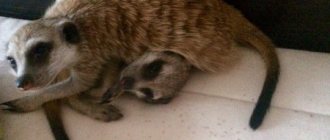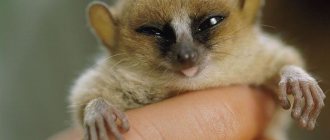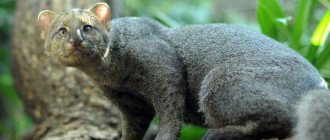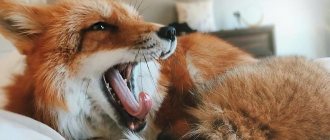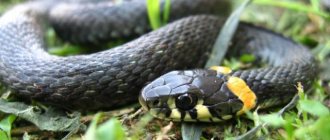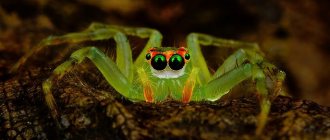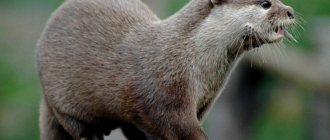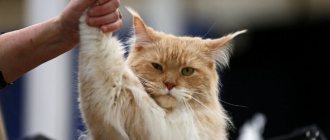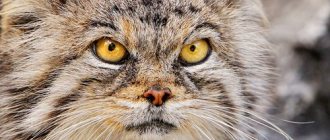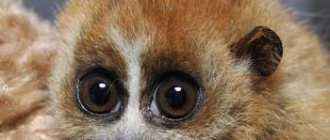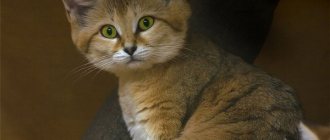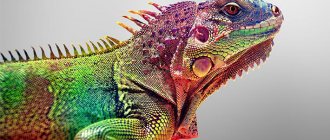Ailurus fulgens, Red panda
- Fact:
The red panda is a regular in mixed forests, in which numerous conifers grow. Fir trees predominate among them - Fact 2:
The panda's fur is universal and allows it to adapt to the climate variations in which the animal can exist. - Fact 3:
The red panda can be found in Southwest China, Bhutan, Myanmar, Nepal, and also in Northeast India - Fact 4:
The height of the animal in a standing position reaches 64 cm, the minimum figure is 50 cm. Moreover, the animals have a fluffy tail 28-48 cm long
Many people have never seen this cute animal alive, but even one look at a photo of a red panda is enough to fall in love with the eared pranksters forever. For any zoo or animal park, this animal becomes a real pearl, which is not only interesting to study, but also causes affection to everyone. Let's learn about the features and history of this magnificent species of pandas.
Origin of the panda
The red panda is a member of the panda family and belongs to the genus of small pandas. For the first time, such funny herbivores became known a long time ago; references are found in Chinese writings of the 12th century. However, the European public learned about these animals only in the 19th century. This can with a clear conscience be called the merit of Thomas Hardwicke, the famous English general of that time. This man was extremely educated and inquisitive, including in the field of studying the animal world. In 1821, the general conducted his own research in the British colonies, during which time Hardwick managed to collect numerous material about the red panda. The military man suggested calling the animal “Hha” - that’s what the local Chinese called it, comparing the name of the animal with the sounds it is capable of making.
Not all Chinese adhered to this name; some Asians characterized the red panda as “punya” or “han-ho”. These differences may be due to the numerous dialects and linguistic differences that characterize the Chinese language.
Officially, the honor of discoverer of the red baby went to naturalist scientist from France Frederic Cuvier . While Hardwick was busy with his affairs in the colonies and at the same time conducting research, the Frenchman worked on completing and publishing his works about a new species of panda. To give the work weight and scientific academic quality, Cuvier named the discovered species Ailurus fulgens, which is translated from Latin as “brilliant cat.”
The English side was dissatisfied with the fact that the French scientist was crowned with the laurels of the discoverer. The British Empire tried to protest, but, according to the rules adopted at that time, the discovery of a new animal was assigned to Cuvier, who duly formalized and confirmed his naturalistic research. Red pandas were included in all textbooks and scientific works under a Latin name, the assignment of which was also considered one of the signs that the discoverer was a certain person.
The incident gave cause for gloating to zoologist Michael Roberts, who was skeptical about the scientific searches of the unprofessional scientist General Hardwick. According to Roberts, the Chinese animal is much more suitable than the name proposed by the military; another name is suitable - the Latin one chosen by the Frenchman. The zoologist insisted that the term “brilliant” used organically describes the essence of the animal, since it is one of the cutest creatures on earth. A faded “kha” or “hha,” according to Roberts, did not at all reflect the characteristics of the panda, which captivated the hearts of everyone who saw it.
Historical premises
The official discoverer Federic Cuvier also called the animal he described one of the most beautiful four-legged creatures. The public also believed that the chosen name was more suitable than any other for the cute animal, and also perfectly described its essence. In addition, “xha” is a much more complex word for the European language.
Even the British themselves, of whom General Hardwicke was a compatriot, did not support his position in this dispute. For the English perception of society, another name for the panda, used by the Chinese, “Punya,” seemed easiest to understand. Gradually, this designation came into use in the circles of biologists and naturalists. As a result, the animal was sometimes called a similar-sounding word - panda, although the red representatives of this family are not very similar to classic pandas.
A missionary from France, Pierre Armand David, also studied this cute animal in the 19th century. He lived in China for a long time, and in 1869 he studied the flora and fauna of this Asian country. Among the Frenchman’s works was a description of an animal very similar to “xha”.
This animal had similar teeth and also lived in dense bamboo groves. Due to the similarity in the structure of the jaw apparatus and the same habitat, both animals began to be called pandas. The larger specimens became “giant pandas,” and the smaller ones, which differed in appearance, became “little pandas” or “red pandas.”
It took some time for scientists to establish a connection between pandas and other representatives of the world of predators. Some believed that red pandas were closer to bears or raccoons. Only more professional and in-depth research of the genetic material made it possible to prove that the newly discovered species belongs to the panda family.
The spectacled bear, which is found in South America, is closest to the red representatives of this family. In general, the family ties of the animal we are interested in are quite complicated. Thus, as a result of archaeological excavations, it was established and proven that the red panda is a direct relative of the giant pandas. In the course of evolution, these two species began to develop separately, but their common ancestor is another ancient animal, quite large in size. Previously, this creature lived in Eurasia, and later dispersed to many places around the world.
Archaeologists found the remains of this fossil in places as far apart as China and England. Moreover, scientists have discovered that red pandas once lived in North America in the territory of the modern United States, and more specifically in present-day Tennessee and Washington. It is possible that representatives of the panda family lived there, quite similar to red red pandas.
Even after studying the red mammals themselves and their ancestors, experts still have questions. Studying pandas in their natural habitat turned out to be quite a difficult task, and the animals in menageries and zoos differed in their behavior and characteristics from their counterparts living in natural conditions. Only recently have scientists become interested in a more detailed study of the life of red pandas, who spend all their time in the wild and not in an enclosure.
Raccoon family
The raccoon family includes 7 genera and 18 different species, which are extremely different from each other in appearance and lifestyle. Representatives of raccoons have spread throughout the tropical and subtropical regions of the United States. In Europe you can only find the raccoon, and in Asia - the red panda. Almost all species of the family, with the exception of noses, prefer nocturnal life. A common feature of all species is complex relationships within the group and between representatives of different sexes. Raccoons are also predatory animals that feed on small vertebrates or invertebrates, as well as fruits.\
Appearance and characteristics
The height of the animal in a standing position reaches 64 cm, the minimum figure is 50 cm. Moreover, the animals have a fluffy tail 28-48 cm long. The color of the tail differs from the rest of the body - it has stripes. The weight of a male red panda ranges from 3.7 kg to 6.2 kg, the entire female weighs up to 6 kg, with a minimum of 4.2 kg.
The animal's fur is brownish-red, with a nutty tint. Below the color is darker, giving off a blackish appearance. The white muzzle of the animal has a short shape, and the edges of the panda's ears are the same color. The ears are quite noticeable in size and have a pointed shape. Around the eyes of the animal, the color combines white and red, the coloring quite strongly resembles glasses or a mask.
Moreover, each specimen has its own specific design of this muzzle decoration. Experts often use this drawing to distinguish individuals from each other. In general, the color of the red panda can be called camouflage - it allows the small animal to hide in bamboo thickets and remain unnoticed by potential offenders.
The animal's legs are short but strong. With their help, this panda representative grabs onto tree trunks and easily moves through space, finding a quiet and safe place. The red panda is not a social animal; it likes to spend time in a hollow during the day, curled up and covering its head with its large fluffy tail. On the ground, the animal is not so maneuverable; it generally prefers to rarely go down. As soon as something scares the little panda, she immediately climbs back up into the trees. The animal is quite clean, maintaining a beautiful and tidy condition of its fur. After eating food, the animal carefully licks itself and then washes its face with its paws.
Habitat (area)
The red panda can be found in Southwest China, Bhutan, Myanmar, Nepal, and Northeast India. The animal’s habitat is mountainous areas at a level of 2-4.8 thousand meters in altitude.
There are mainly two types of red pandas - the red (red) red panda and the green panda. The first, also called the Stayana panda, lives in China in the east and northeast of the country, and is also found in Myanmar. The second type of panda prefers to live in the western territories of Nepal and Bhutan.
Panda Staiana has dark fur and is larger in size compared to her brother. Even among animals of the same species, the coloring can differ significantly: some have more yellowish or nutty shades in their pigmentation, while others have more chocolate and nutty shades. The red panda usually lives in places with a cool climate, and therefore thick fur helps the animal cope with harsh weather conditions. The winter and summer periods in the places where the animal is located differ slightly in temperature and vary greatly in the number of rainy days.
The panda's fur is universal and allows it to adapt to the climate variations within which the animal can exist. The average annual temperature in the territories under consideration is in the region of 10-25 degrees, and the amount of precipitation can reach 350 cm per year. This natural area is characterized by abundant humidity, showers and fog. All this creates the preconditions for the emergence of lush and succulent plants and trees in Asian territories, the leaves of which the animal happily eats. In addition, crowns of bamboo or thickets of trees hide a calm animal from the unwanted eyes of other animals and humans.
What do they eat and how do they live in the wild?
The red panda is a regular in mixed-type forests, in which numerous conifers grow. Fir trees predominate among them, but other trees are also found. The deciduous part of the forest is represented by various deciduous varieties of flora. In the undergrowth in those places there are rhododendrons and bamboo groves, which are favorite places to hang out for little pandas.
The structure of the teeth and the characteristics of the body allow the animal to be a full-fledged predator, but it so happens that red babies eat mainly plant foods. It accounts for 95% of all feed consumed. The favorite delicacy of these pandas is bamboo; both leaves and stems are used. The calorie content of such food is low, so the animal has to constantly chew in order to provide itself with the necessary energy for life. According to scientists, the animal eats up to 4 kg of bamboo leaves and shoots per day. The required subsistence minimum is 1.5 kg . Coarse fiber is difficult for the red panda's digestive system, so prudent animals choose the softest and juiciest parts of bamboo and other plants.
In winter, bamboo thickets do not please the discerning consumer with fresh shoots and leaves, so the panda has to eat berries, eggs of small birds, and also, surprisingly, small rodents. It's hard to imagine this cute animal in the role of a merciless predator. If the caloric content of the diet is not enough to satisfy all needs, the panda becomes lethargic, its vital energy and immunity decrease. Typically, in nature, an animal can live 8-15 years, the exact period depends on the habitat and other unstable conditions.
Where to keep a pet
After all the pros and cons of keeping raccoons at home have been considered and the positive aspects have won by a clear margin, it is necessary to pay special attention to the pet’s place of residence.
An animal with a long nose is by nature very active, energetic, loves to climb a lot, explore and even swim. Therefore, you should evaluate the size of your own home and the possibility of sharing it with such an active resident.
The ideal option in this case would be a spacious enclosure with a house if you start a dog in a private house.
Important! If you keep a coati in an apartment, then you need to provide it with a large spacious cage of at least 2 * 1.5 meters. In addition, periodically take the animal for walks.
If it is possible to install a swimming pool for the nose, it is definitely worth doing this, since the animal loves water very much.
Reproduction, offspring, family creation
When communicating with other individuals of its species, the red panda quietly puffs and uses low characteristic sounds. During communication, animals also raise their large, colorful tails, wave their heads, and open and close their mouths.
The breeding season for the red panda traditionally begins in January. After pregnancy, the female carries the baby for 50 days. It happens that 145 days pass between mating and the birth of the baby. Scientists explain this by slowed development of the fetus, which is called diapause.
The female usually takes care of the offspring, but there are exceptional cases in which the male helps. The babies grow up in a nest that their mother makes from branches and leaves. Usually the rookery is located in hollow trees or natural caves.
Like kittens, little red pandas are born blind. They weigh only 100 grams and are much paler in color than their parents. Usually a female gives birth to 1-2 cubs, but more can happen. Often only one of them manages to reach puberty. Pandas' eyes open in the third week of life. At three months, the baby already darkens and becomes similar to its ancestors; it is ready to leave the nest from time to time in search of food.
What do noses eat?
The diet of the raccoon nosukha does not require a special approach, and it can be fed in a variety of ways. But it’s still better to choose those foods that he is used to eating in his usual wild environment:
- chicken eggs;
- quail eggs;
- chicken, rabbit, turkey;
- fish;
- potatoes, carrots, zucchini;
- berries;
- a variety of fruits - from apples and pears to kiwi and avocado.
The more varied an animal's diet, the more cheerful and healthy it will grow. In case you suddenly have nothing to feed the raccoon, you can give it cat or dog food diluted with water.
Enemies, in captivity, man
These animals have few enemies, however, this species was listed in the Red Book in 1988. Now there are only 2,500 red pandas living in the world . Their population is declining, partly due to human destruction of bamboo forests. Another 350 of these animals live in captivity in 85 menageries around the world. But in unnatural environments, red pandas do not reproduce. However, in nature, animals also do not please with abundant offspring. An animal often gives birth to only one baby, and this happens only once a year. Many young individuals die before reaching sexual maturity, which occurs only at one and a half years.
But people are making a lot of efforts to preserve red pandas both in the wild and in captivity. This gives reason to hope that many more generations of people will be able to see what kind of animal this is.
How to determine rabies in a raccoon?
Classic symptoms of rabies: aggression turning into depression, drooling, hydrophobia, photophobia, “sagging” of the lower jaw, paralysis of the pharynx, larynx and hind limbs.
Interesting materials:
How to remove the engine from emergency mode? How to withdraw GU Juba? How to withdraw property from collateral? How to bring a grape snail out of hibernation? How to bring a hamster out of hibernation? How to breed a new breed of horse? How to remove rust stains from light-colored clothes? How to remove iodine stains from colored fabric? How to remove a red wine stain on a linen tablecloth? How to remove a stain from a white T-shirt at home?
